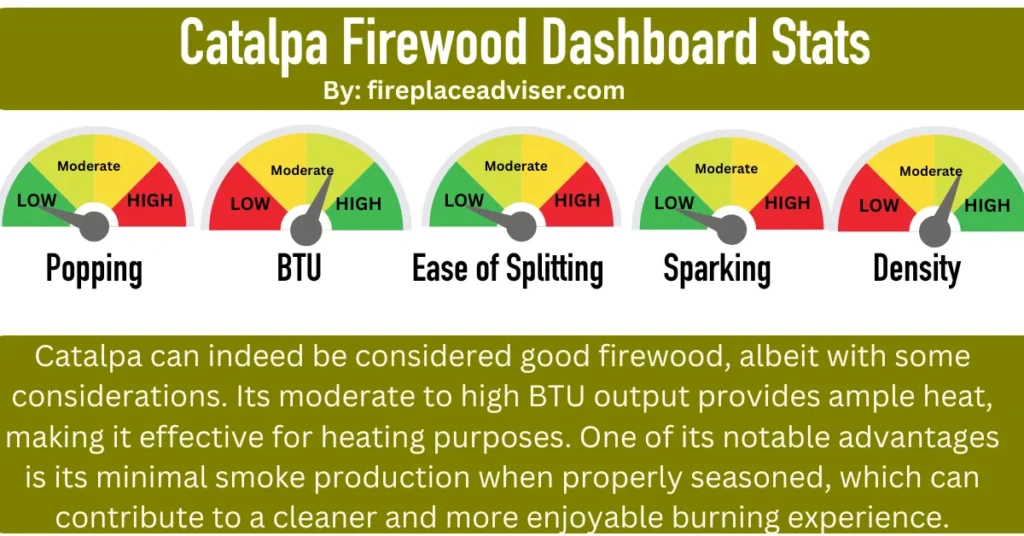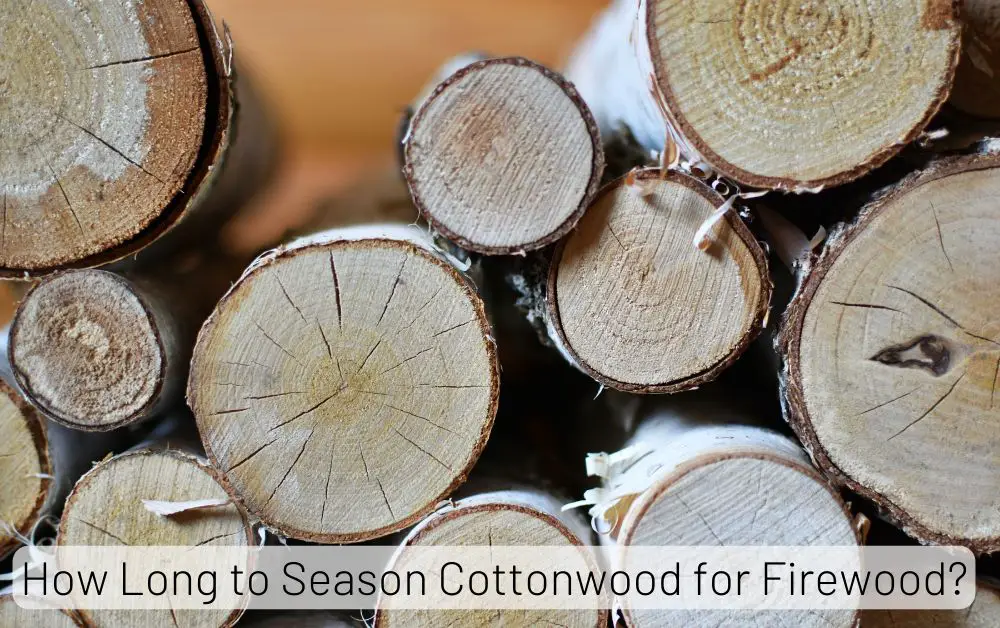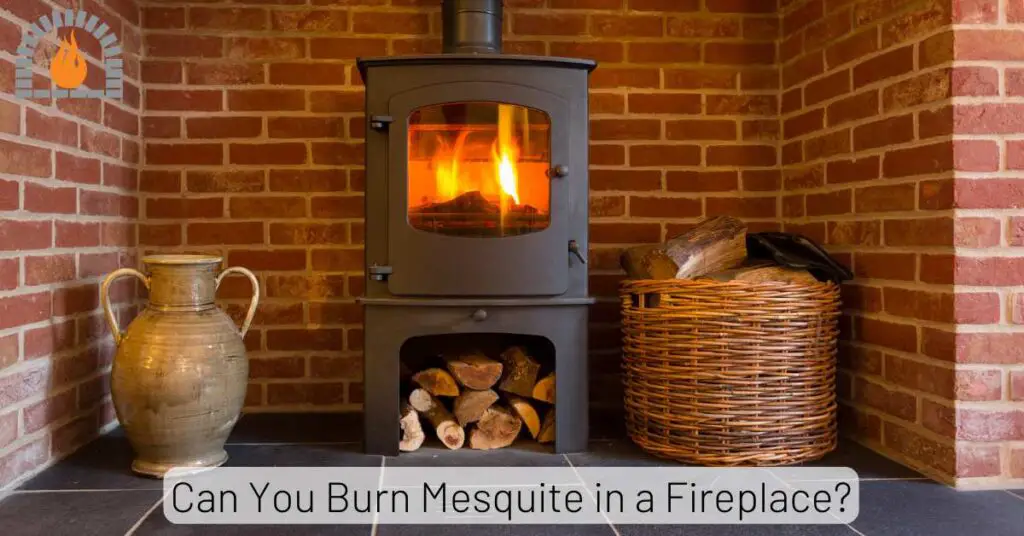In the realm of sustainable living and responsible resource management, Catalpa wood emerges as a beacon of eco-friendly promise. Often overlooked in favor of more traditional firewood options, Catalpa offers a wealth of benefits that extend far beyond mere warmth. Is Catalpa good Firewood?
Catalpa is a great choice for both indoor and outdoor fires due to its moderate heat output and low moisture content. One of its notable advantages is its minimal smoke production when properly seasoned, which can contribute to a cleaner and more enjoyable burning experience.
From its renewable nature to its impressive burning properties, Catalpa firewood presents a compelling case for reevaluation in our heating practices.
Join us as we delve into the world of Catalpa firewood, exploring its origins, characteristics, and the myriad ways it can revolutionize the way we heat our homes while honoring our commitment to environmental stewardship.
Overview
| Catalpa Firewood Characteristic | Description |
|---|---|
| BTU | Moderate to high, providing ample heat output. |
| Smoke | Minimal smoke when seasoned properly. |
| Popping | Low popping tendency, relatively safe to use. |
| Sparking | Minimal sparking, suitable for indoor use. |
| Seasoning | Requires moderate seasoning time, around 6-12 months. |
| Splitting | Relatively easy to split, manageable for most users. |
| Moisture Content | Initially high moisture content, needs proper drying. |
| Density | Moderate density, burns steadily and evenly. |
| Aroma | Mild, pleasant aroma when burning. |
| Insect Resistance | Resistant to insect infestations, less prone to damage. |
| Longevity | Durable firewood, offers long burning times. |
| Environmental Impact | Renewable source, sustainable harvesting possible. |
Is Catalpa Good Firewood?
Catalpa can indeed be considered good firewood, albeit with some considerations. Its moderate to high BTU output provides ample heat, making it effective for heating purposes. One of its notable advantages is its minimal smoke production when properly seasoned, which can contribute to a cleaner and more enjoyable burning experience.
Catalpa has a low tendency to pop and spark, making it safer for indoor use compared to some other types of firewood and is relatively easy to split and has a moderate density, allowing for steady and even burning.
Its mild and pleasant aroma adds to its appeal as a firewood choice. Catalpa also boasts resistance to insect infestations, contributing to its durability and longevity as firewood.
However, it’s important to note that Catalpa initially has a high moisture content and requires proper seasoning for optimal burning performance. This process typically takes around 6 to 12 months.
Once seasoned, Catalpa can offer a sustainable heating solution due to its renewable nature and environmental benefits.

Catalpa Firewood Pros and Cons
Pros:
- Catalpa firewood provides moderate to high heat output, making it effective for heating purposes.
- When properly seasoned, Catalpa produces minimal smoke, contributing to a cleaner burning experience.
- Catalpa has a low tendency to pop and spark, making it safer for indoor use compared to other firewood types.
- Catalpa is relatively easy to split due to its moderate density, ensuring convenient handling and preparation for burning.
- Burning Catalpa emits a mild and pleasing aroma, enhancing the ambiance of the surroundings.
- Catalpa is resistant to insect infestations, resulting in less damage and longer durability as firewood.
- Catalpa trees can be sustainably harvested, making it an environmentally friendly option for heating needs.
Cons:
- Catalpa firewood typically has a high moisture content when freshly cut, requiring proper seasoning for optimal burning performance.
- Catalpa wood needs to be seasoned for around 6 to 12 months to reduce its moisture content and improve burn efficiency, requiring patience from users.
- Proper preparation and seasoning are necessary to unlock the full potential of Catalpa firewood, which may require initial effort and time investment.
- Catalpa trees may not be as widely available as some other types of firewood, potentially limiting accessibility for some users.
- While Catalpa is relatively easy to split, its moderate density may result in shorter burning times compared to denser hardwoods.
Related Post: Is Dogwood Good Firewood?
Comparison with Other Firewood Types
To better understand Catalpa firewood’s characteristics, it’s helpful to compare it with other commonly used firewood types.
- Oak: Oak is renowned for its high density, slow-burning properties, and long-lasting coals, making it a preferred choice for many firewood users.
- Maple: Maple wood burns hot and produces a pleasant aroma, making it a popular choice for indoor heating.
- Pine: Pine wood ignites easily and produces a lively flame, but it tends to burn more quickly and may produce more smoke and residue compared to hardwoods like Catalpa.
Best Practices for Using Catalpa Firewood
To maximize the benefits of Catalpa firewood and minimize potential drawbacks, certain best practices should be followed.
- Properly season Catalpa wood by allowing it to dry in a well-ventilated area for an adequate period, typically at least six months to a year.
- Stack firewood in a manner that allows for sufficient airflow to facilitate drying and minimize moisture retention.
- To prevent creosote buildup and reduce the risk of chimney fires, clean the chimney regularly, especially when burning wood with higher moisture content like Catalpa.
Related Post: Is Black Cherry Good Firewood?
FAQs
Is Catalpa wood suitable for cooking or smoking meats?
While Catalpa wood burns cleanly, it may not impart desirable flavors for cooking or smoking meats compared to woods like hickory or apple.
Can I burn Catalpa wood in a fireplace or wood stove?
Yes, Catalpa wood can be burned in both fireplaces and wood stoves, but it’s important to ensure proper seasoning and maintenance to prevent chimney issues.
How does Catalpa wood compare to cedar for outdoor fires?
Catalpa wood burns cleaner than cedar and produces less smoke, but cedar may offer a more aromatic experience for outdoor fires.
Does Catalpa wood produce sparks when burning?
Catalpa wood typically produces fewer sparks compared to softer woods like pine, but it’s still important to use caution and have appropriate safety measures in place.
Can Catalpa wood be used for woodworking projects other than firewood?
Yes, Catalpa wood can be used for various woodworking projects, especially those that prioritize ease of working and unique grain patterns.
Final Thoughts: Is Catalpa Good Firewood?
In conclusion, Catalpa firewood offers a blend of advantages and disadvantages that make it a viable option for certain users. Its ease of splitting, moderate heat output, and minimal smoke production can make it an attractive choice, particularly where it is readily available.
However, users should be mindful of its slow drying time and the potential for creosote buildup, taking appropriate precautions to ensure safe and efficient use.
Affiliate Disclosure: Fireplaceadviser.com is a participant in the Amazon Services LLC Associates Program. We may earn a commission when you click on certain links on this site and purchase.

Hello!! I am Jamal Khan. I often fix my home electric heaters and gas stove problems and research the common issues in the heating units to improve my knowledge and expertise. The aim of establishing fireplaceadviser.com is to share my expertise and knowledge with my audience.


















